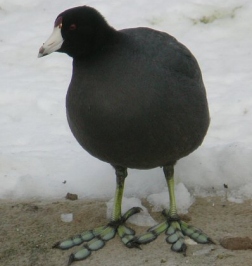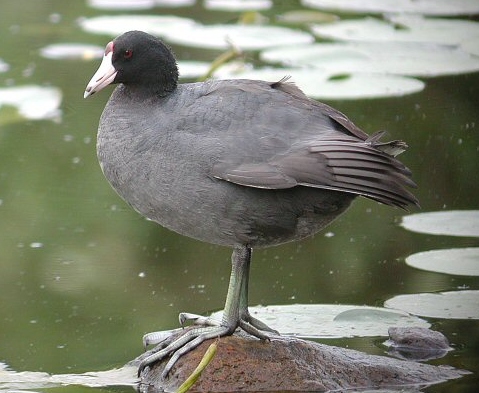|

Medium-sized, chicken-like swimming bird, dark gray to black overall,
short, white bill and undertail coverts.
Toes are lobed, not webbed. Upper edge of frontal shield is red, but
usually only visible at close range.
Swift direct flight with rapid wing beats, feet protrude past tail.

|
AMERICAN
COOT
Fulica americana
GRUIFORMES
Rails and Coots (Rallidae)
Range and Habitat
Breeds from British Columbia, western Canada, and New York locally southward.
Usually spends winters north to British Columbia, Kansas, Illinois,
and Massachusetts. Preferred habitats include open ponds and marshes.
Found on coastal bays and inlets, often occurring in large rafts during
winter.
Even though the American Coot swims like a duck,
they do not have webbed feet, the toes have lobes on the
sides of each segment.

SOUND: "ke-yik", "k-rrk"
Coots
are kleptoparasitic, which means that when
they don’t feel like hunting for their own food,
they’ll steal their meal from other birds.
They are nicknamed "marsh hen" or "mud hen" because
of they way their heads bob when they walk or swim.
A group of coots has many collective nouns, including a "codgery",
"commotion", "fleet", "shoal", and "swarm"
of coots.
The American Coot is native to numerous countries in North and Central
America. This bird has also been seen in Iceland, Ireland, Greenland
and Portugal. The range of the American Coot is estimated to be about
11 million kilometers. It is believed to be possibly extinct in Ecuador.
Despite the possible extinction in this one country, the population
of the American Coot is about 6 million individual birds. The evaluation
level of the American Coot changed from Lower Risk to Least Concern
in 2004. The population of this species is not thought to be in immediate
danger of decrease.

|